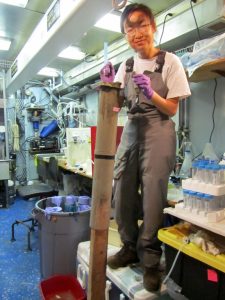Study Identifies Oil Degraders that Stand Ready for Hydrocarbon Inputs
– September 2, 2014
Using high-resolution DNA sequencing of specific marker genes to analyze microbial community composition, scientists tracked the diversity and abundance of water-column bacteria before and after the Deepwater Horizon oil spill.
They found a striking transition as a few specialized oil-degrading bacterial groups temporarily dominated the diverse microbial community near the wellhead immediately after the spill and returned to pre-spill levels about five months later. Molecular analysis of bacteria collected near the spill site from October 2010 to September 2011 continued to find small populations of oil-degrading Oceanospirillales and other minority bacteria. Their presence may indicate the persistence of widely occurring microbial seed populations with the genetic potential for response to natural or anthropogenic hydrocarbon influxes. The team published their findings in the January 2014 online edition of Deep Sea Research II: Topical Studies in Oceanography: Pulsed blooms and persistent oil-degrading bacterial populations in the water column during and after the Deepwater Horizon blowout.
From May 2010 to July 2011, researchers monitored the microbial community in and around a deep-water oil plume near the spill site and compared results with a bacterial composition baseline from water collected in March 2010 at 800 meters depth and ten nautical miles northwest of the blowout. Using pyrosequencing of 16S rRNA genes (a ribosome gene complex that can be used for distinguishing species) to complement clone libraries, they extended the timeline of microbial oil spill response and expanded previous molecular water column analyses.
The pre-plume bacterial composition contrasted sharply with the oil-contaminated bacterial composition, showing a corresponding spike in hydrocarbons and opportunistic bacteria. Oceanospirillales strongly dominated the May 2010 deep plume samples. Cyloclasticus and Colwellia, recognized to degrade aromatic hydrocarbons, were the most substantial minority population. Genome sequencing of Oceanospirillales cells revealed that they possessed alkane-oxidizing genes. By September 2010, the deep plume had drifted in a generally west-southwesterly direction away from the wellhead. Analysis of water samples near the spill site collected from then to July 2011 showed dominant bacterial group compositions similar to pre-spill compositions.
The pyrosequencing survey validated a diverse community of hydrocarbon-degrading bacteria in the plume profile that went largely undetected in the clone libraries. In post-plume samples collected near the wellhead, Oceanospirillales that had disappeared from the clone libraries remained detectable at low levels in the pyrosequencing dataset even though the plume was no longer detectable.
Researchers suggest that local sources for these oil-degrading bacteria (such as small-scale accidental leakage, natural seepage, or a re-suspension of oil particles) may reintroduce them into the water column. The rapid enrichment of specific bacterial types associated with the deep hydrocarbon plume may indicate the existence of easily accessible natural reservoirs or seed populations of Oceanospirillales in the Gulf of Mexico. Identifying the natural reservoir for these bacteria could improve understanding of their ecology and adaptability to a massive and prolonged oil input.
While alternative interpretations are possible and need investigation, the team suggests that their results may have caught the last stages of a methane-eating bacterial bloom that pushed methane concentrations below typical Gulf of Mexico ambient levels in September 2010.
The study’s authors are Tingting Yang, Lisa M. Nigro, Tony Gutierrez, Lindsay D’Ambrosio, Samantha B. Joye, Raymond Highsmith, and Andreas Teske.
In separate studies, several of these authors provide additional findings related to microbial responses and their role in hydrocarbon fate: the June 2013 issue of PLos One, Role of bacterial exopolysaccharides (EPS) in the fate of the oil released during the Deepwater Horizon oil spill; and the May 2013 issue of International Society for Microbial Ecology, Hydrocarbon-degrading bacteria enriched by the Deepwater Horizon oil spill identified by cultivation and DNA-SIP.
************
This research was made possible in part by grants from BP/The Gulf of Mexico Research Initiative (GoMRI) to Ecosystem Impacts of Oil & Gas Inputs to the Gulf (ECOGIG). Other funding sources included an award from the National Oceanic and Atmospheric Administration to the to the National Institute for Undersea Science and Technology at the University of Mississippi (for initial cruise on R/V Pelican); the National Science Foundation (RAPID Response NSF-OCE 1045115, OCE-1043225 for the R/V Walton Smith cruise, and EF-0801741 for the R/V Atlantis cruise); the National Institute of Environmental Health Sciences (grant 5 P42ES005948) and a Marie Curie International Outgoing Fellowship (PIOF-GA-2008-220129).
The GoMRI is a 10-year independent research program established to study the effect, and the potential associated impact, of hydrocarbon releases on the environment and public health, as well as to develop improved spill mitigation, oil detection, characterization and remediation technologies. An independent and academic 20-member Research Board makes the funding and research direction decisions to ensure the intellectual quality, effectiveness and academic independence of the GoMRI research. All research data, findings and publications will be made publicly available. The program was established through a $500 million financial commitment from BP. For more information, visit https://gulfresearchinitiative.org/.
© Copyright 2010- 2017 Gulf of Mexico Research Initiative (GoMRI) – All Rights Reserved. Redistribution is encouraged with acknowledgement to the Gulf of Mexico Research Initiative (GoMRI). Please credit images and/or videos as done in each article. Questions? Contact web-content editor Nilde “Maggie” Dannreuther, Northern Gulf Institute, Mississippi State University (maggied@ngi.msstate.edu).






